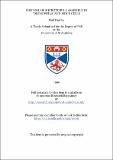Control of microtubule assembly in 'Drosophila' and MDCK cells
Abstract
Various aspects of microtubule nucleation and organization have been investigated m Drosophila and MDCK cells. Drosophila indirect fibrillar flight muscles (IFMs) do not possess centriole-containing centrosomes. The ends of both microtubules and developing myofibrils closely associate with specialized cell junctions called myotendon junctions which are located at the ends of developing muscle cells. Antisera raised against pericentrin, a protein involved in microtubule nucleation, stain myotendon junctions throughout myofibrillogenesis. The antisera also stain the centrosome/spindle poles of Drosophila embryos and cultured Drosophila epithelial cells. Hence, microtubules may be nucleated at the myotendon junctions of IFMs rather than by sites associated with nuclear envelopes as in vertebrate muscle cells. Incipient MDCK daughter cells form an extremely short intercellular bridge. This contains the mid-body and ends of two mid-body associated microtubule bundles. Eventually the two microtubule bundles completely lose contact with the mid-body. These microtubules may have been severed. Consequently, the furrow base can constrict around the mid-body to complete daughter cell separation. A non-affinity purified y-tubulin antiserum stains an antigen closely associated with both sides of the mid-body. This antigen is not y-tubulin. The antigen appears to be associated with a recently discovered mitotic organelle (the telophase disc). Taxol induced microtubule arrays contain 'chains' of microtubules in interphase neuroblast cells of Drosophila third instar larvae. Adjacent microtubules in these 'chains' appear to share several protofilaments. Preliminary results indicate that microtubules of taxol induced asters are composed of 12 rather than the normal 13 protofilaments in MDCK cells. The centrosome may nucleate and release microtubules in interphase MDCK cells. y-Tubulin is only concentrated at the centrosome of control and taxol-incubated interphase MDCK cells. Microtubule ends do not focus at the centrosome in either case. The centrosomally-associated microtubule array increases substantially in size from anaphase to late telophase. At late telophase the array spreads throughout each incipient daughter cell. Subsequently, the array ceases to focus at the centrosome. y-Tubulin and pericentrin initially concentrate at the centre of two of the several taxol-induced microtubule asters in each mitotically arrested MDCK cell. Subsequently, y-tubulin and pericentrin are concentrated at two closely associated discrete spherical sites. These sites are not associated with microtubule asters. This may represent a very clear example of microtubule release from the centrosomes in these cells.
Type
Thesis, PhD Doctor of Philosophy
Collections
Items in the St Andrews Research Repository are protected by copyright, with all rights reserved, unless otherwise indicated.

